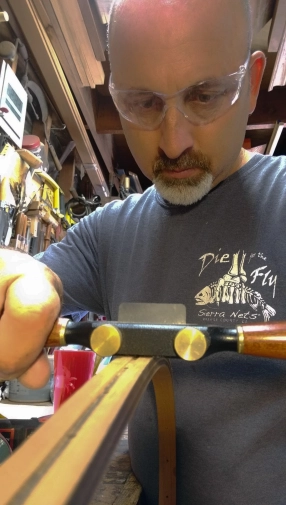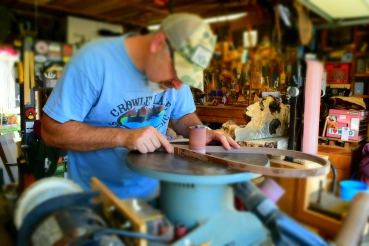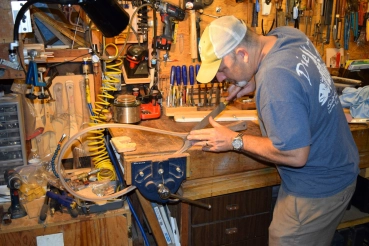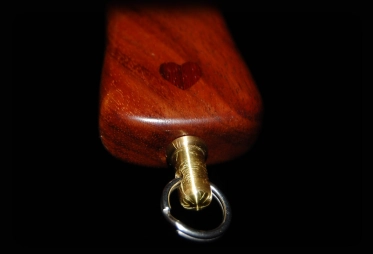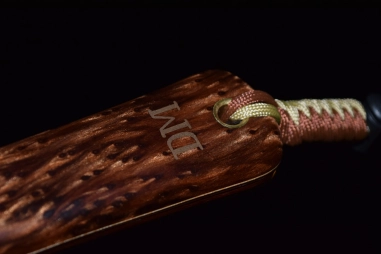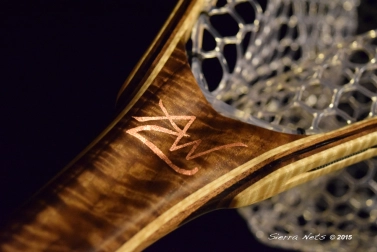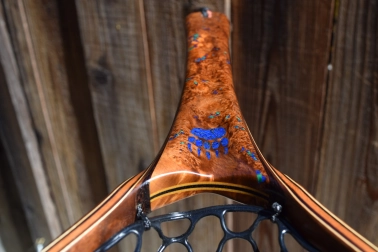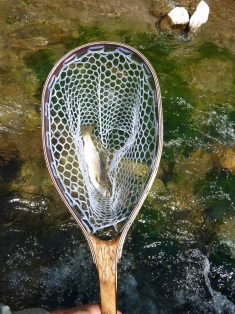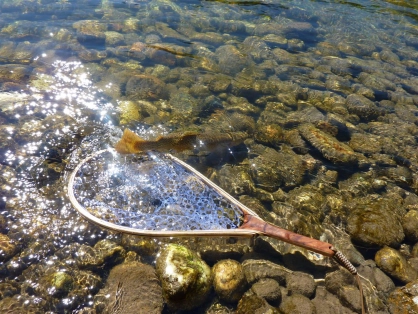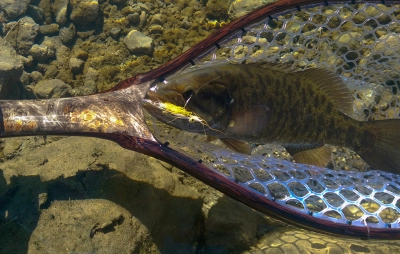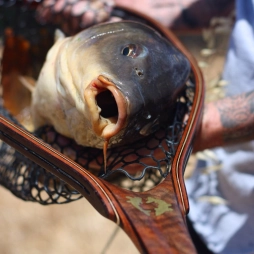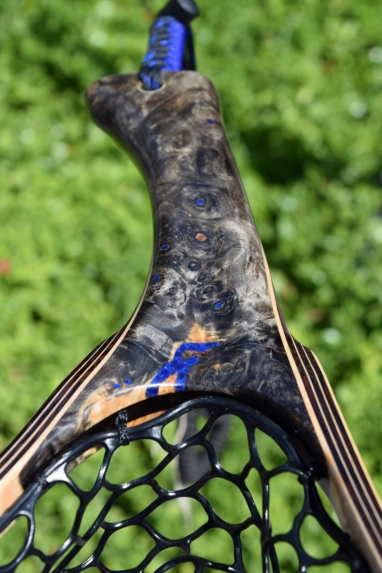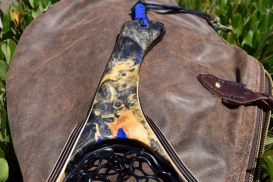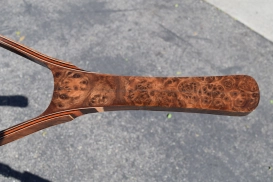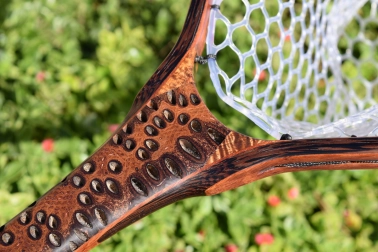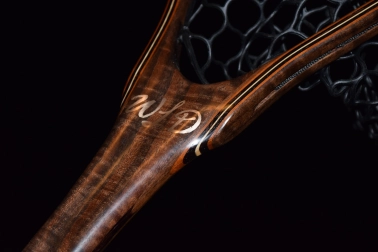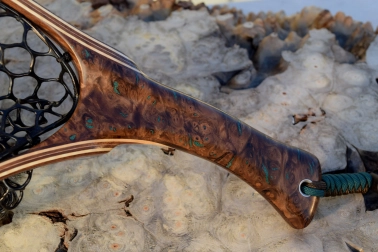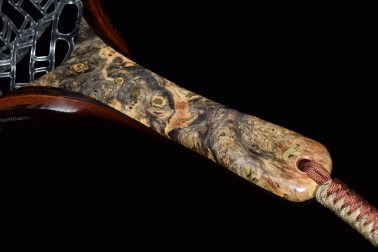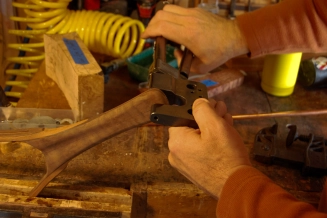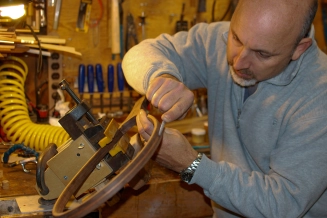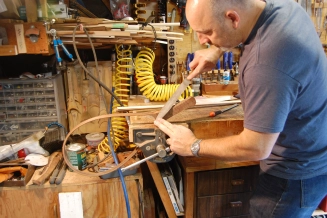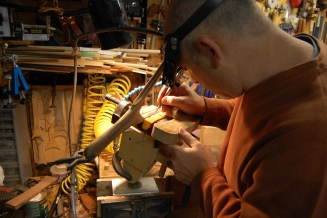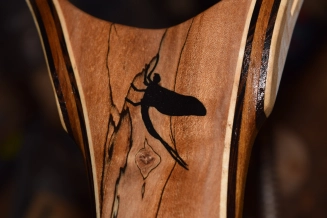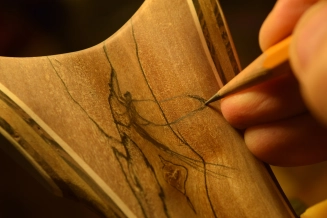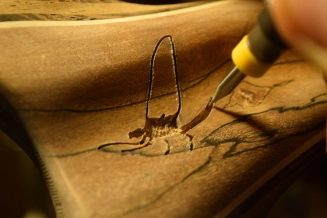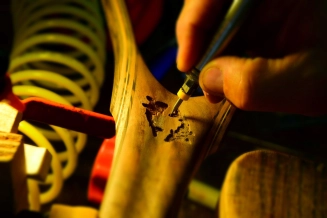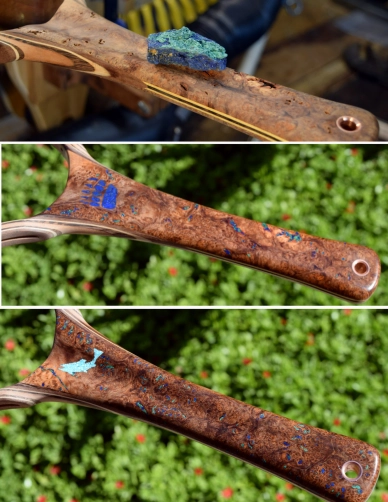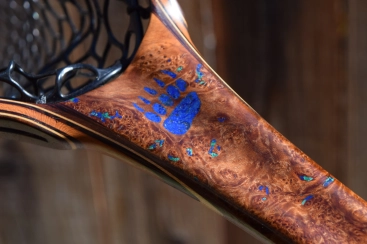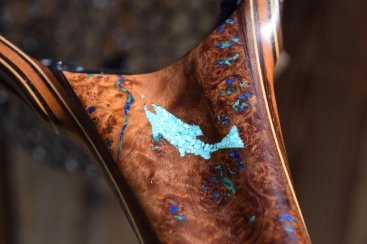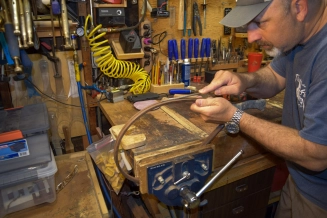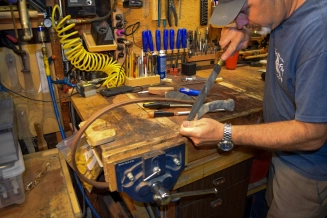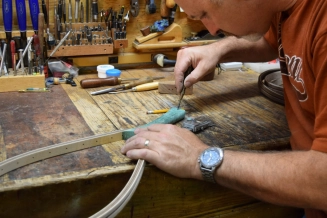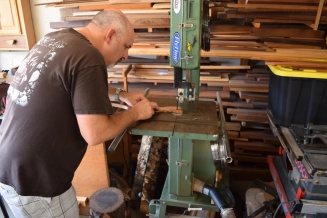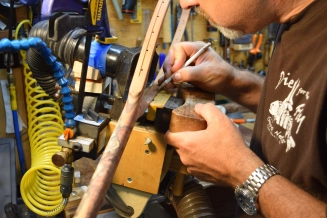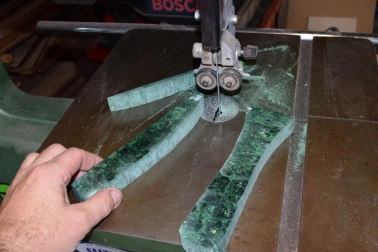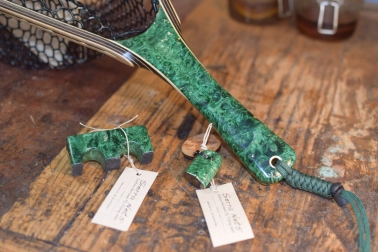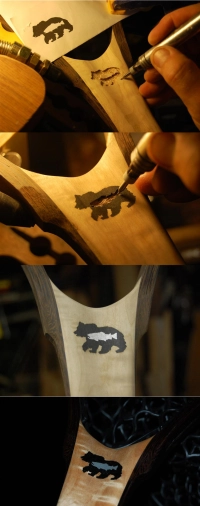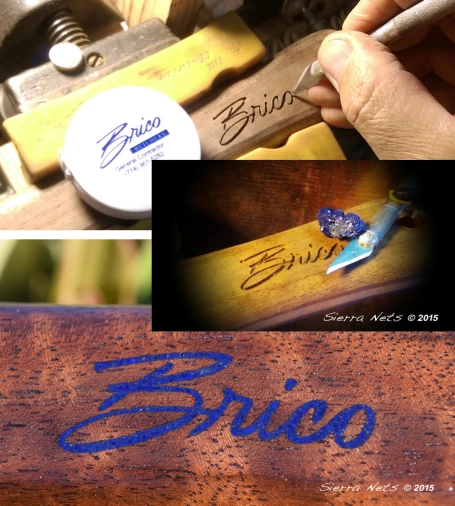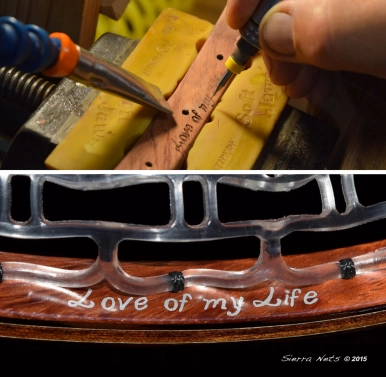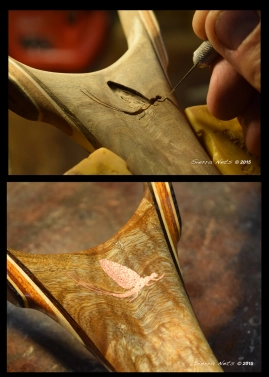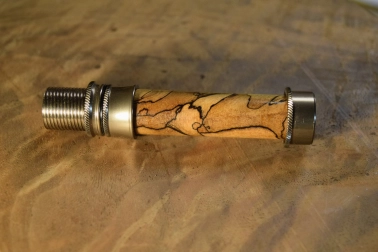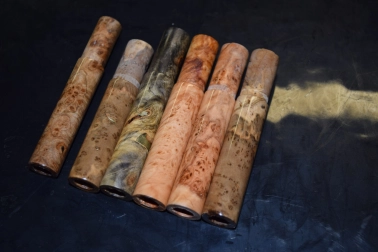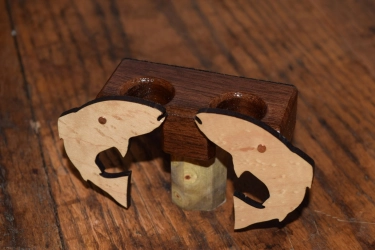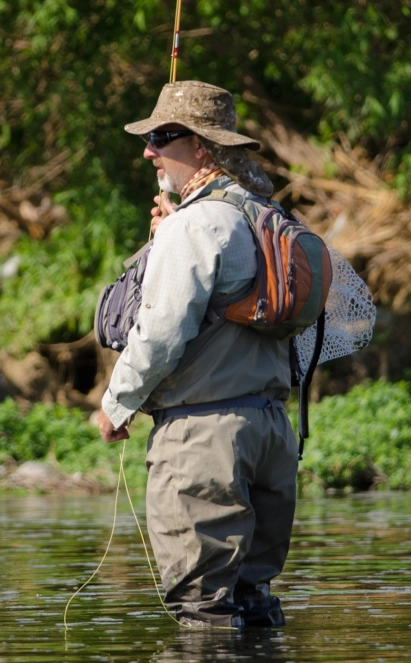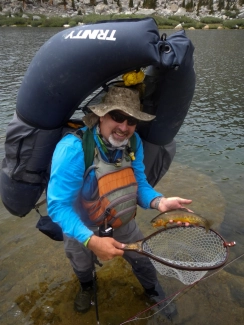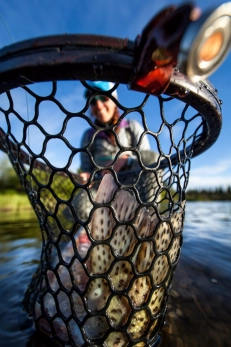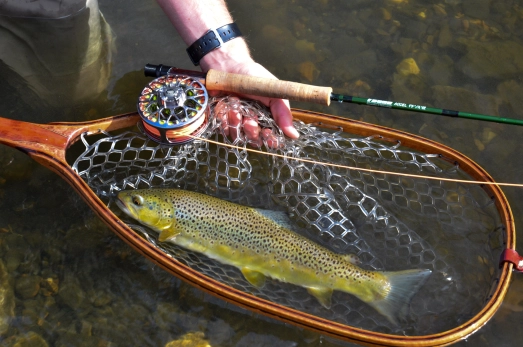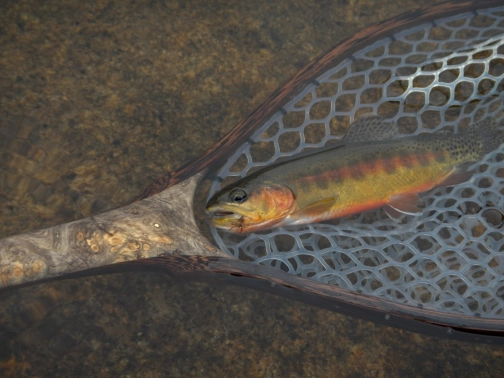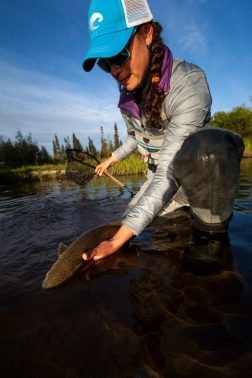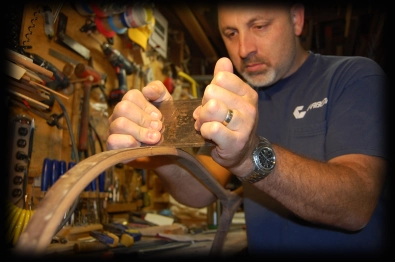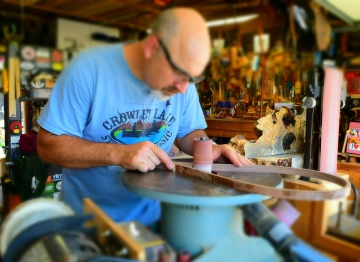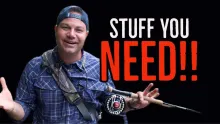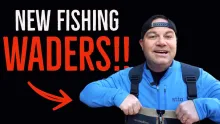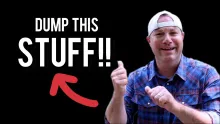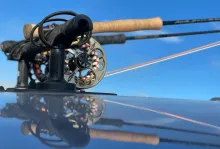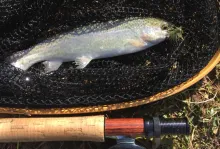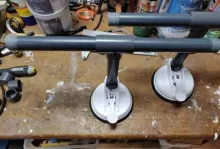A Q&A session with California based landing net maker Greg Madrigal from Sierra Nets
We have covered rod makers, reel seat makers, scrimshaw makers and people with many other crafts and skills here on the Global FlyFisher. This is the first net maker we portray: Army veteran Greg Madrigal from Sierra Nets based in Garden Grove, California. South African Korrie Bros has asked some questions and Greg has replied.
1. When did you start making nets and accessories?
Believe it or not, it all started when I saw an article in a woodworking magazine sometime around 2002 and thought it would be a cool project that I could use in my new fly fishing adventures. I pretty much replicated the net in the article and still have it and occasionally fish it today. The thing is built like a tank, but frankly, it's not comfortable to use. I made 2 more nets for a charity raffle a couple of years later, and when they were well received, It planted a seed for what would eventually become Sierra Nets.
2. Did you have woodworking experience before you started or was it learn on the job and from mistakes?
I had quite a bit of experience actually. My father was a poor general contractor who mostly took on small jobs for property managers. I remember having to get up with him early every Saturday, when other kids were watching cartoons, to be his right-hand man. With six kids to feed, I really didn't have a choice. I think I soldered my first whole-house copper re-pipe when I was 15 years old. He had many of the tools that I would come to use later in life. His table saw became mine when he passed away in 2001, and I used it to build many pieces of award-winning furniture for both my wife and some extended family. I also did some woodworking for my Army unit back in the mid-90s. That said, building nets is quite unique in that you need specialized equipment, materials, and skills. The learning curve is quite long but it's been a fun ride that I am proud of.
Greg Madrigal
3. Do you have standard net shapes that you work from or is it pretty organic and you end up "what the wood tells you"?
I do have many different forms for the hoops and handles, but they are always being mixed and matched to create a new look and feel. Some clients come to me wanting a small hoop with a long handle because they have trouble bending over or use a long rod. Others may want a tiny hoop and handle to fit inside particular backpacking pack. These are all things I consider when talking with new clients. Since many of them are from other parts of the world, I can't talk to them face-to-face. So, I ask a lot of questions about how they are going to use the nets and then design their net based on those answers. I definitely let the wood "speak to me". For instance, I am building three nets for a gentleman in New Zealand right now and one of the nets initially was supposed to have black inlaid spots to represent a Brown trout. After assembling the net using some Burl's and some finer details that he initially wanted, I suggested that maybe the spots would detract from the overall design. He completely agreed and so we omitted that customization. The net is looking fantastic and that client is ecstatic.
4. How do you decide on what wood to use for a specific net?
First off, I'd like to share my philosophy on woods. I decided early on that I would build the very best net I can, today, using all of my talents, best practices, and best woods. I don't hold onto rare or extraordinary woods waiting for the "right client" to come along. You can be sure that whatever wood I use on your net will be the best I have access to, and I have a lot of extremely beautiful woods! I stock/use woods based on their coloration, durability/strength, and beauty. To decide which woods to use, I usually have a conversation with the client who has already been enamoured by a particular net I've built. This conversation generally drives the design and woods used. Oftentimes, a client will love many nets and asks me to make the artistic call. These nets often become my best work as I am able to let the wood "speak to me". Regardless, most of my net handles are professionally stabilized. This amazing process involves the wood being placed in a vacuum chamber filled with a liquid resin. The air is evacuated which pulls air bubbles out of the wood pores. Once this process is completed, they introduce high-pressure to the vacuum chamber which forces the liquid back into the wood pores. The wood is then baked for an hour or so to catalyze the liquid into a clear crystal-like hard resin. This is the same process used to make custom knife handles and renders the wood super hard, water resistant, and resistant to expansion and contraction.
5. You add a lot of embellishing and inlays to your nets, when did this start and how do you find inspiration for the inlays?
I was always an artist growing up and loved to draw things. Most of my drawings were of animals and were created in pencil, but I also dabbled in oils and acrylic paints. So, the addition of my hand carved mayfly and fish inlays were a natural progression. I have to draw the inlay on the net first anyways but then I have to carve it out using a dentist drill-like tool. I use laser on occasion when it's requested but almost always hand carve the embellishments you see on my website.
6. Is this your full-time job?
This is my full-time job.
I went full-time back in late 2010 and have almost never been without some sort of backlog of work. I LOVE my job! It feeds my creative juices - something often sorely lacking working in large corporations these days. Often times, my clients become my friends. Consequently, I have invitations to fish all over the world. I mean, how could you not hit it off with somebody who shares the same passion as you? Besides that, when's the last time you talked to somebody about fly fishing and they were pissed off? When I talk to clients, they are stoked and raring to go. Yeah, I love my job.
Jim Stimson
7. What made you quit your full-time job?
Back in 2007 the great recession hit and I was laid off from my plant manager position at a high-end wooden door and window company. I struggled to find my way after that doing some consulting on CNC equipment integration and continuous improvement in manufacturing. I found a job in early 2009 with a company that made wooden cabinet components and prospered for the first year there. The second year was a bit of hell on earth as the recession caught up to this industry leading company as well. The stress in my top management position became overwhelming and I sought out my doctor and asked, no, demanded, a treadmill stress test. He told me I was fine physically but suggested I find a different path. Mentally speaking, the stress was literally killing me. This is when I made the decision that turned my life around. I decided that I could merge my two hobbies into a business and make the finest heirloom fly fishing nets in the world. That was literally my goal. I named the company after a place near and dear to my heart, the Sierra Nevada mountains. I've hiked and finished these mountains since I was a kid. It's a very special place.
8. Do you only make to order or specifications or do you produce "bulk" orders as well?
Almost every net I build is a custom commission. I did recently get a 12 net order from Trout Unlimited which is technically a bulk order, but every one of the 12 is different in some way. I also build a few custom nets every year to benefit charity. My nets, along with a few other items from fine builder-friends of mine, have raised over $10,000 for Project Healing Waters and Casting for Recovery.
9. Do you only work in specific wood or do you have woods that you prefer to work with? If so why?
I like to use burls in my handles. Buckeye, Box Elder, Redwood, Carolina Cherry, Thuya, and Claro Walnut are some of my favorites. They are so unusual, especially in the handle space, that it’s a great conversation starter. They’re also extremely photogenic as you’ll see on the Sierra Nets on the Water web page on Sierra-nets.com. You typically see burls used in luxury car dashes, or on fine furniture, but rarely on nets. Why? Because they tend to be lineally weak-The exact opposite of what you want in a handle that will be lifting (hopefully) heavy fish and banged around on boulders and such. The burl of a tree is akin to a cancerous tumor. It’s as if the tree is trying to sprout but it keeps forming scar tissue at the base of the shoots, then more shoots, then more scar tissue and so on. This is why it’s weaker than regular wood. It tends to form a ball which is why you almost never see long pieces of burl. On a good day, I can make a 14" long handle from a single piece of burl. How can I make net handles from inherently weak woods? By stabilizing them. I used to stabilize my own wood, but realized pretty quickly that it's a job best left to the experts. I now exclusively use the leading professional stabilizer in North America and they do one hell of a job! Furthermore, other precautions are taken like laminating the handle to one or more laminates of strong woods like wenge, to form a sort of backbone. We also press in and flare the metal lanyard ferrules into the handle to create an additional layer of strength.
10. What if a customer has his own wood or a piece of wood that might hold sentimental value, can he supply it and will you use it? If so, how will you incorporate it in the net?
On occasion, a client will ask me to create a net using wood from somewhere nostalgic. I have built nets from childhood play-trees, old barns, deceased fathers' wood stash, and even incorporated a deceased grandpa's silver from his jewelry making days. Basically, I work with the client to establish the best and highest use of any particular piece of wood whether it be from a family tree or a piece they bought on eBay.
11. The hoop of the net, is there any specific wood you use or will any wood work?
There's one wood I love to incorporate into the hoop, and that is wenge. Wenge is a beautifully contrasting dark Brown(almost black) wood that I believe is stronger than steel pound for pound. I like to use at least a couple strips of wenge to add rigidity and strength to the. When I don't use it, I tried to pair woods that are strong in and of themselves. I make a conscious effort to make a beautiful hoop that stands up to abuse.
12. If a fly fisher has his own ideas, will you use it or incorporate it in the manufacture of the net?
Absolutely, and this happens often. It's one of the benefits of having a custom net built. You can get exactly what you want in terms of look, feel, length, weight, bag type, embellishments, and accessories. I've even customized leather cases and magnetic net releases for clients. A lot of times people want something nostalgic like embedding a pendant in the net handle or inlaying a particular Bible verse into the net. I actually like it when the client makes it their own and shows interest in the design. Many times I will take pictures during the build and send it to these clients because I know they are interested at that level. I even offer a slideshow video of the build. It's a great way to capture and share the extraordinary lengths I go through to create each and every net.
Greg Madrigal
13. What do you use for the net part of the net? Mesh, knotted nets or the new rubber/silicone netting material and why?
I try to steer people away from the mesh nets for a few reasons: Rubber netting will not smell like fish at the end of the day. It doesn't retain water like mesh and soak your back with fish slime. Your hooks will not get permanently stuck (even with pinched barbs) in a rubber net. Finally, and most importantly, it is easier on the fish's slime coat - they kind of slide around like they're on ice. I'm not going to sit here and tell you that there are no cons to using the rubber net. These things don't bother me but some people complain that they are heavy and bulky.
14. Where is your factory/studio based?
I work out of my home studio near Disneyland in Southern California USA. The weather here is just beautiful most of the year and permits me to work more hours in my unheated, non-air-conditioned studio. I am extremely lucky and very grateful for that. However, I am a country boy trapped in the city. I love to work outside my studio and listen and watch for birds. As silly as this sounds, they help keep me connected to nature .
15. Are you "old school woodworking" or do you use modern machines, i.e. CNC in your production as well?
I guess you could say I am old school since I don't use any computer-aided equipment other than CAD. Also, there is value in a company not always growing. Not too many businesses today think this way, but I guess I am old school. If I can’t build it right, I don't build it. That's not to say I am not productive because I am. I have created some of my own custom tools to do some of the oddball processes that a fly fishing net requires. There is a set of clamps that I recently modified with a MIG welder that really sped up my glue-up process. Recently, I also had a friend make me another pair of clamps that I designed in CAD. It too made a huge difference in the speed in which I can glue up a net. Right now, I am currently in the process of building a custom drilling machine that will enable me to drill the hoop holes in a quarter of the time it used to take me. I have been dreaming about this Franken-machine for a couple of years and I'm excited see it come to life! I also use a lot of hand tools like planes, rasps and files to shape the handle until it feels good in my hand.
16. How do people go about when they want to order a net or your accessories and what is the process when they do order?
I think the best first step is to go to the order page where I explain the process of ordering a custom net. In a nutshell though, one would typically look at my Instagram, Facebook page or the Sierra Nets Sold page on my website to see what is possible and what they like. They would then contact me via email, social media or a phone call where we would discuss and document the particulars. From there I create an invoice which will be emailed. A down payment secures the order in my backlog of work.
Camille Egdorf
17. Do you only fly fish or do you do other forms of fishing as well?
I will fish conventionally if that is the only way, but I have almost no desire to do so. I always say you can catch just about any fish on the fly that you can on conventional gear. Heck, many times I can out fish conventional guys! For me, It's just the whole process of fly fishing. It's a circle that begins with tying your own flies, then reading the water, presenting the fly and ends with getting the take. I dig all of that!
Contact
Sierra Nets web site
Sierra Nets
12868 Newhope Street
Garden Grove
CA 92840
USA
Phone +1 714-305-1026 • fax: +1 714-539-1818
Email: info@sierra-nets.com
18. What is your philosophy regarding the green movement?
My green philosophy is to use sustainable sources of wood and packing materials. Much of my wood comes from local urban lumber from trees cut down in people's yards, city trees, or firewood from firewood lot's. I know a great lady who knows her woods and can pick out the best stuff from a giant heap of firewood. She has relationships with a few lots who give her access. She knows the kind of woods I can use and often gives me first choice since my yield is so high from a given piece of wood. In contrast, she also sells wood to wood turners who sometimes make a bowl out of a large chunk of Burl and most of it ends up as sawdust on the workshop floor. Much of the wood I have in stock was pulled from dumpsters at places I worked in the past. It's amazing what large companies throw away. I also try to use only recycled packing materials. The bubblewrap and foam I use comes from a local furniture delivery company, and everything I use diverts foam and other packing materials directly away from landfills.
Greg Madrigal
- Log in to post comments

